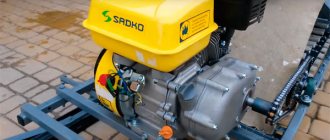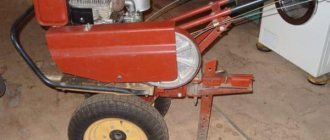The structural components of exhaust pipes on many cars fall into the category of problematic parts. They rust quickly, often burn out and break. Replacing the exhaust system is also not an option, since it can become unusable after serving for less than a year. Some car enthusiasts prefer to make a muffler with their own hands and try to use more durable consumables. What do the step-by-step instructions look like, and what will you need to complete the work?
The exhaust pipe system may seem quite simple, but this is just the first impression. In fact, it implements a number of functions, including not only noise reduction, but also reducing the toxicity of exhaust gases, their temperature and sound intensity during fuel combustion. In the muffler area, due to dispersion, the exhaust is finally deprived of temperature and speed indicators. How can you make a muffler with your own hands, and which methods should you give preference to?
What does white smoke from the exhaust pipe mean? You can find the answer to this question in the detailed material of our author.
We also recommend reading our specialist’s article, which talks about how to make a flame arrester for a car with your own hands.
There are several options that car enthusiasts use to make a muffler for their car with their own hands. The choice of a specific method depends on the exhaust system tuning option and the size of the budget you are counting on. This could be a muffler made from a powder fire extinguisher or the manufacture of a straight-through muffler.
Powder fire extinguisher muffler
Modification of a standard muffler is possible on the basis of a powder fire extinguisher whose service life has expired.
Necessary materials
Additionally, you should prepare:
- welding electrodes 1.5 - 2.5 mm;
- electric welding machine;
- compact grinder with cutting wheels for metal;
- parts of the old muffler;
- two pieces of steel pipe with an internal diameter of two inches.
Stage-by-stage execution of work
The manufacturing process is as follows.
- Prepare a pipe of a suitable size with a diameter of 30 - 52 mm. It is unlikely that you will be able to find thin-walled factory-type pipe, so just use tap pipe.
- Unscrew the cap from the fire extinguisher and get rid of the remaining powder.
- Enlarge the hole until the pipe you prepared fits snugly into it.
- A similar hole must be made on the other side of the cylinder, but it should be slightly shifted towards the wall of the fire extinguisher.
- Use a grinder to create perforations on the end sections located inside the pipes (12 - 15 cm).
- Insert the pipes into the cylinder, calculating the opposite arrangement of the perforated sections opposite each other. The ends should be inserted 60% into the balloon.
- Weld the joints on both sides of the cylinder in a circular direction. Be careful not to burn the metal of the fire extinguisher.
- Remove the fasteners from the old fire extinguisher and weld them onto the resulting homemade structure. Please note that the water pipe is heavier than the factory car pipe, so provide reinforcement for the fastening. On the other hand, the heavier the pipe, the quieter the muffler.
- To reduce noise levels and increase the service life of the structure by two years, insert a flexible corrugation into place after the exhaust manifold. The housing can be filled with glass wool to further reduce noise.
- If you are making a muffler from stainless steel, provide for the possibility of disassembling the structure. It can be partially dismountable, and you will have the opportunity to periodically clean the cavities and make repairs if necessary.
- Be sure to check the tightness and reliability of the welds by plugging one of the pipes and filling it with water upside down. There should not be even a slight leak.
- Drain the water and use a compressor to blow out the product and remove any remaining moisture.
- The design is ready for installation on a car.
We also advise you to carefully read our expert’s article, which describes in detail how the muffler resonator is designed.
You may also be interested in an article by our specialist, in which he talks about how to choose a thermal tape for a muffler.
Types and their differences
There are several types of mufflers and each has its own individual characteristics. Each is described in detail below.
Reflective
They are sometimes called reactive. The operating principle is based on multiple reflections of sound. This is achieved by changing the diameter of the tubes or the number of branches.
Resonator
These are the same jets, but with a slightly modified design. Sound attenuation is achieved thanks to the weakly damped resonances of its elements.
There are several types of mufflers
Restrictive
This is the simplest type of device, based on replacing a large hole with a small one. Which significantly reduces engine power.
Absorption
A simple but not very effective muffler, the action of which is based on the absorption of sound waves in a noise-absorbing material. Usually this is basalt wool laid around the gas outlet pipe.
About direct flow or PG
A direct-flow muffler (PG) is an improved alternative to a stock exhaust, which is not capable of ensuring a quick and timely release of gases from the engine system (ICE). The standard exhaust system especially suffers (chokes) after installing a sports camshaft or after boring the cylinder head cylinders (in other words, on a forced engine).
A straight-through muffler is designed to improve the exhaust system
The GHG is designed to modernize the exhaust system, which increases gas emissions. In addition, a correctly installed PG will provide an increase in internal combustion engine power by 10–15 hp. However, you need to be prepared for drastic changes: everything will need to be replaced, from the catalyst to the tip.
Features of tuning the ZMZ-405 engine
Among the types of ZMZ tuning, one cannot fail to note 3 subtypes:
- Forcing.
- Turbocharger.
- Inlet.
Let's consider each of them separately
Forcing. Tuning the ZMZ-405 engine is inconceivable without boosting. It makes it possible to increase the air power of the internal combustion engine. To do this, a vessel for air intake is installed on the shafts, the combustion chamber is modified, and the diameter of some channels is increased.
Turbocharger. Supercharging is in demand to increase the power of internal combustion engines. In the case of tuning the ZMZ-405, a reinforced piston group (forged) is installed and more powerful, high-performance injectors are installed.
Inlet. When tuning the ZMZ-405, the fuel intake system is often modified, changes are made to the operation of the injectors for better distribution of the fuel-air mixture.
What is required to build an ASG (direct-flow exhaust system): tuning kit
Undoubtedly, installing a PG is a tuning, a modernization. And everything you need to build such a sporty exhaust option is available in stores.
The first is the resonator. Note that the sports PG does not have partitions that prevent the escape of gases. Its entire design is aimed only at ridding the internal combustion engine of excess gases generated during fuel combustion. As a result, power increases due to increased airflow.
Interesting point. On cars equipped with a naturally aspirated internal combustion engine, installing a sports PG allows you to increase power by 10 percent of the standard power, and on turbocharged cars - by 20 percent or even more.
The second necessary element, of course, is a new direct-flow flame arrester. The universal damper is intended as an alternative to the standard catalyst when constructing a direct flow. Such an element must be made of stainless steel (there is an option of aluminized steel). The internal part of such a flame arrester has a universal design, designed to increase the power of the machine’s power unit.
The structure of the muffler in the form of a diagram gives a complete picture of it
Fastening elements and other accessories, which must include various adapters, adapters, flanges, thermal tape for the exhaust manifold, etc., are also part of the system.
And finally, the muffler pipe, made of stainless steel or aluminized. The pipe itself must have an increased diameter (usually in the range of 38–76 mm). The length of the pipe is about 1000 mm, the wall thickness is 1.5 mm.
The Importance of Schemas
You can understand the fundamental importance of the Gazelle 405 electrical circuit simply based on how often this car has to be repaired. After all, as a rule, it is bought not for personal needs, but as a commercial machine. This means that he travels every day. You also need to make allowances for the conditions in which Gazelles drive, and how they are usually used:
- How to make a booster for washing heat exchangers with your own hands
- Exposure to natural conditions (poor wire insulation, short circuits).
- Poor build quality (cheap and bad wires that do not last long).
- Bad fuel, which has a detrimental effect on the electrical components of ignition and injection.
And only by using the electrical diagram can you figure out where which device is located and which wires are suitable for it.
If you try to replace something in the system yourself, without looking at the diagram, you can simply mix up the wires and do something to the car that you will then have to change all the wiring in the car.
Each car is equipped with an electrical diagram, which indicates all the devices and equipment used in the car, as well as the connection circuits. The functionality of the wiring is very important for any vehicle, since its damage can significantly complicate the operation of the car. What elements does the Gazelle electrical circuit include, what malfunctions are typical for it? Find answers to these and other questions below.
Do-it-yourself PG from handy materials
If you can’t buy ready-made tuning kits from the store, then that’s okay. You can make a homemade muffler from handy materials. However, it is not recommended to use old, used mufflers for this, since as a result of repeated heating cycles, their metal loses its original properties.
Made of stainless steel
Stainless steel exhaust gas is the most expensive method of exhaust modernization, but also more effective. But if we also take into account the high levels of protection against aggressive environments, then this option can last for many years, and thereby save money.
To make a homemade PG from stainless steel, you need to do the following:
- take a stainless steel tube of the required diameter (the length is determined by the car model);
- put several metal brushes on it (sold in stores under the name “metal sponge”);
Metal brushes are designed in the direct-flow muffler to reduce noise
- wrap the pipe with sponges on with pieces of thin metal mesh;
Metal mesh is needed to wrap the direct-flow muffler and eliminate noise
- you need to wrap tightly so that there are no voids left (see photo);
Wrapping the muffler with a metal mesh should be done very tightly
- after wrapping, secure with wire (steel, not copper!);
- insert such a sandwich into a stainless steel pipe with a thicker diameter or wrap a stainless steel sheet over the wire;
- hammer ursa - mineral wool inside;
Ursa mineral wool gets clogged inside the muffler
- rivet the surface stainless steel sheet, first making holes in the sheet for the rivets with a drill;
- cover one of the holes of the homemade resonator with a mixture of ursa and cement (prepared in a ratio of 1 mineral wool x 3 cement).
Filling the hole with a fireproof mixture is a mandatory step in the operation of making a homemade muffler.
Step-by-step manufacturing instructions
Before you make a muffler for your car yourself, take care of two important things that are best ordered from a turner: end caps and baffles. The rest will be easy for you to handle on your own.
To make a muffler for a car and successfully install a homemade product, you need to follow the recommendations:
- Take measurements and form a jar assembly from a metal blank.
- Drill holes in the can pipes.
- Weld the pipes to the reflectors and baffles.
- Attach and secure the casing and end caps.
- Install fasteners.
- Fasten the finished part.
Making a muffler with your own hands
After installing a new exhaust device, the sound of the motor may change: become stronger or quieter, which depends on the quality of work.
How to make a straight-through muffler quieter
The PG becomes quieter as it is collected. And each craftsman does this differently, using mineral wool, metal shavings, brushes or asbestos. It is also recommended to arrange several compartments inside the homemade muffler, creating additional resonance.
The installation of direct flow in various ways involves the use of mineral wool, shavings and other fillers
A car with an exhaust louder than 96 dB does not pass inspection, does not cross the border, and does not drive around the city. This is the law. Sound today is limited even in motorsport, where it would seem there should be no restrictions or boundaries.
Having decided to suppress the GHG, you need to understand that this should in no way affect the effectiveness of the new system. None of the components of the GHG system should create resistance to exhaust gases.
Flute
The flute or silencer in the PG is a simplified design used by tuners. Its task is to “calm down” the SG, obtaining legitimate dB at the output.
Making a flute is not difficult. It will be enough to use as a muffler a piece of a perforated 20-centimeter tube with a diameter that is slightly larger than the exhaust (by 1/3). A disk or conical washer must be fixed to the pipe to act as a plug. Fastening is carried out using bolts at the air cut. The washer, in fact, creates a structure that resembles a flute.
The flute is used in PG to reduce noise
The cost of ready-made silencers in stores varies from $8 to $150. Chinese models are very cheap, but don’t expect quality from them. Original, good European-made flutes can be purchased for $100–$150.
You can assemble a flute for the PG yourself. Below is a diagram by which you can easily make such a model.
A homemade flute is easy to assemble
A homemade flute is easy to assemble:
- take a 20-centimeter steel pipe (it is recommended to use stainless steel) and a sheet of iron 1 mm thick;
- welding is carried out (preferably arc);
- Initially, a plug with holes for 8 bolts should be welded to the pipe.
It is recommended to fasten it with all 3 bolts, but you can do it with 1. It will be much faster.
Damper
A SG with a damper is a universal opportunity to simultaneously increase the power of an internal combustion engine and ensure quiet forward flow. A design of this type has been known to car enthusiasts for a long time; it is even found as standard on some BMW models.
The operation of the GHG damper is based on the following principle. When the engine operates at low speeds, gases exit through a standard, conventional muffler. At this time, the SG is closed by a damper. But as soon as the internal combustion engine reaches high speeds, the damper in the PG opens, and due to enhanced ventilation, optimal torque is produced.
The damper is controlled automatically, for example, on a BMW. But manual models are also known.
The price of a ready-made system with a damper can be high, especially for cars with automatic transmission. So, the cost of such a system, together with a titanium spider, is approximately 2-3 thousand dollars.
Analogue models, similar in capabilities to the original ones, are more moderately priced. However, a successful upgrade of this option may require the specific knowledge of an experienced minder.
Direct flow with a damper is considered the most effective option for increasing the power of an internal combustion engine
You can make a damper yourself, but it is impossible to predict the result of such an installation. It's better not to take risks.
Whatever option for manufacturing PGs is chosen, ready-made models and kits should not be excluded. In some cases, it will be much easier to buy them than to bother with pipes, a welding machine and fillers.
How else to reduce exhaust system noise
The resulting sound and additional power will likely only appeal to the owner of the new muffler and his congenial friends. For the rest, some noise reduction measures can be provided when this is critical.
Typically, either a controlled damper on the exhaust or a removable conical insert in the form of a perforated tube with an expander, also called a flute, is used.
The flute can be quickly installed or removed when it is not needed, and the damper, reminiscent of the throttle of an injection engine, can be controlled remotely, if desired, even from the driver’s seat.
In more complex exhaust systems, even switching flaps are used, when the flow can be directed either to a standard muffler or to a sports direct-flow muffler.
Installing an additional resonator
The resonator must dissipate low-frequency sounds. In case of dull noise, this action will once again dampen the sounds, which makes the machine operate quite quietly.
Another resonator is mounted between the base resonator and the muffler. It is installed in the area where the base resonator was located. This new resonator must have sound-absorbing material. It should fill its internal space.
Two resonators
The sound of a running machine can be reduced as much as possible by installing an additional final muffler. This type of noise reduction device is a specific can, which is crossed by a pipe with holes, and the rest of the sound reduction mechanism is saturated with heat-stable soundproof fiber, which is fixed with a fine mesh. This system for reducing the intensity of a sound wave is called an absorber .
The area for mounting another muffler should be the area between the catalyst and the standard muffler. To attach another sound reduction device, cut a piece of pipe of the required size between the base muffler and the catalyst. Fit the muffler to the resonator using strong clamps in combination with asbestos sheets to create gas-tight joint walls. The sealing must be done very carefully - a missed gap will lead to a lot of noise.
As a result of these actions, when sound waves move through the installed muffler, it is absorbed by the porous substance, which will help reduce the noise from the operating machine. A sound wave, reaching a porous substance, provokes vibrations between different fibers and, appearing during this friction, is transformed into thermal energy. Consequently, sound vibrations are converted into heat. A significant advantage of such a noise reduction device is that there is no need to increase the length of the exhaust system.
Exhaust system design
Technology for creating and mounting an additional resonator:
- Creating a body (barrel) from a fragment of a steel pipe. It should have thin walls. You can also use two halves of sheet steel;
- Creating holes in a certain area of the exhaust device pipe behind the base resonator;
- A combination of body halves on a pipe with holes. Then they are scalded;
- Placement of basalt-based mineral wool into the hollow space of a newly created body;
- Welding the ends of the resonator;
- Adaptation of the ignition and fuel delivery system. This must be done due to transformations in the exhaust pipe.
Upon completion of all production operations, the welds must be cleaned, and the part that was made must be painted. It must be chosen very carefully. It must be very resistant to temperature fluctuations.
After installing the additional resonator, the ignition system and fuel supply should be tested. You need to realize that all changes to the exhaust system will affect the engine. It will be very annoying if, by reducing the volume of the running engine, you are forced to increase fuel consumption or reduce the power of the car. When choosing a method by which you will create a silent muffler, take into account the difficulties associated with it. It is especially necessary to know that absolutely all methods of producing a silent exhaust system increase the severity of the mechanism.
Therefore, the car owner must strengthen the brackets and rubber shock absorbers. Always be aware of the changing balance of incoming air and exhaust gases into the engine. When upgrading the exhaust device, do not forget about the need to thoroughly test the engine's capabilities at various speeds. It is also worth carrying out additional adjustments to the fuel supply and air separation devices.
Installation of a resonator with an absorbing filler
Instead of the basic resonator, another one is installed, equipped with sound-absorbing material inside. Basalt fiber is most often used as a filler. This method is the most expensive.
To replace the resonator with a new one, you need to cut out the old part, insert the resonator with filler in its place and weld it on both sides.
Replacing the old resonator with a new one











